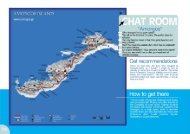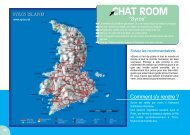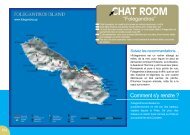Cyclades Guide - Escale Yachting
Cyclades Guide - Escale Yachting
Cyclades Guide - Escale Yachting
Create successful ePaper yourself
Turn your PDF publications into a flip-book with our unique Google optimized e-Paper software.
N A X O S<br />
Naxos is the largest and most fertile island of the <strong>Cyclades</strong>. Its long<br />
history, the important monuments but also its vivid tourism life have<br />
put it in a special position among the other Cycladic islands. No<br />
matter how many days you spend in Naxos, there will always be<br />
something to discover, beaches you haven't seen, towers and<br />
castles you haven't visited yet, ancient temples whose secrets are<br />
yet unknown.<br />
Naxos has a very rich natural environment with many rare species<br />
of fauna and flora, and diverse landscapes: the two tallest<br />
mountains of the <strong>Cyclades</strong> (Zeus, Koronos), coastal and hilly<br />
wetlands, sandy beaches with dunes and cedars, olive groves,<br />
valleys and, to the north, large areas with terraces.<br />
Useful information<br />
According to tradition, the first inhabitants of the island were from<br />
Thrace. Later on the island was inhabited by the Carians whose<br />
leader, Naxus, gave his name to the island. Excavations show that<br />
Naxos had already been inhabited since the Neolithic period, while<br />
during the Early Cycladic period it had several important<br />
settlements, playing a leading role in the growth of the Cycladic<br />
civilization. The geological resources of the island have produced<br />
two famous products: marble, which was used for Cycladic<br />
figurines and ancient kouroi, and emery, which contributed to the<br />
flourish of sculpting in Naxos, as it was used for the final polishing<br />
of works.<br />
63










